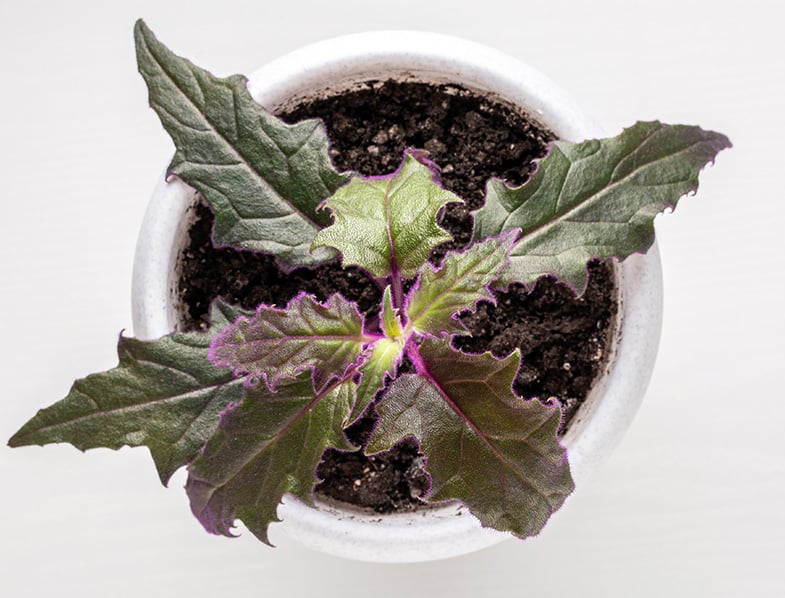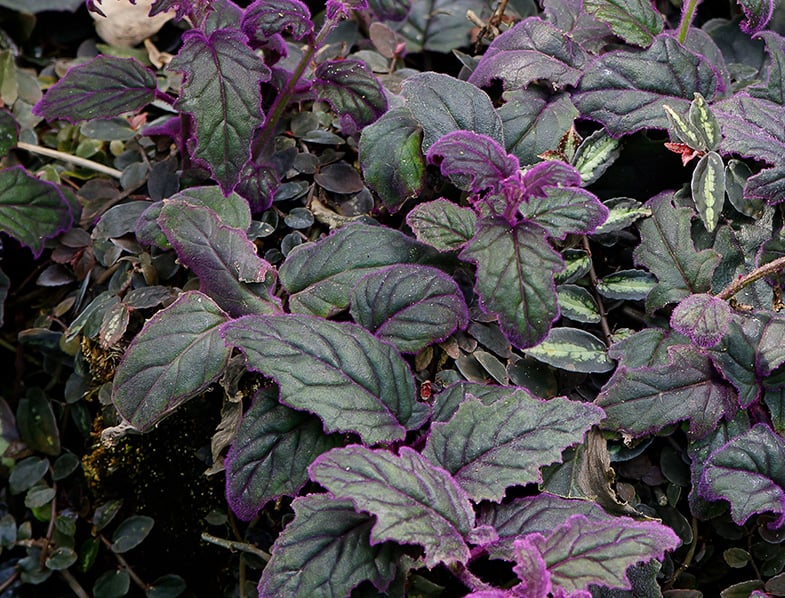If you are looking for a way to create a unique talking point in your home, a purple passion plant is a great way to go about it. The velvet leaves of this shimmery tropical plant are as breathtaking as they are captivating.
The Purple Passion Plant can grow in a pot, or it can be trained as a vine. If you are looking for a plant to hang from a window, make sure to pick up the Gynura sarmentosa. It will vine in hanging or crawling form.
If you are looking for a Purple Passion plant that will grow upright, then you will need to pick up the Gynura aurantiaca. Growing about two feet tall when cultivated indoors, this handsome plant will add character and style to any room.
Unlike other houseplants, the purple velvet plant is not really for beginners. It is an attractive plant to have in the home but requires close attention to detail. It needs a moist atmosphere and bright lights to thrive.
It also needs to remain moist at all times, but the leaves must never get wet. In addition to these concerns, you will need to remember to pinch the flowers in the spring unless you want foul odors permeating the entirety of your space.
As complicated as its care may seem, the velvet plant is a stunning tropical plant that will add character and charm to any room.
Watch Our Latest YouTube Video ...
About the Purple Passion Plant
- The interesting appearance of the purple passion plant makes it popular the world over.
- The Gynura aurantiaca looks as if it is covered in velvet due to the purple hair on the leaves and stems.
- The purple passion plant produces flowers in the spring that are orange in color.
- The more light the gynura aurantiaca gets, the deeper purple the leaves will become.
- Water can permanently damage the velvet texture of the leaves.
- Purple Passion Plant needs a generous amount of water, or it will faint.
- Vining passion plants can grow as long as 4 feet.
- If you are interested in a fast-growing plant, the gynura aurantiaca is a good choice.

Purple Passion Plant Features: An Overview
- The botanical name of the Purple Passion Plant is Gynura aurantiaca.
- The leaves of the Gynura aurantiaca are finely serrated with a dark green base.
- The dark green leaves of the Gynura aurantiaca have dense purple hairs covering them.
- The purple passion plant spawns stinky flowers in the spring which should be pinched.
- After the first flowing, gynura aurantiaca plants start to slowly deteriorate.
- The velvet plant originally comes from Indonesia.
- If your gynura aurantiaca starts to wilt due to lack of water, moistening the soil will quickly revive it.
- The Purple Passion Plant can grow as a vine plant or a potted plant.
- Potted passion plants typically reach two feet in height once mature.
Growing The Purple Passion Plant
Growing the purple passion plant is not difficult, but you will need to be very careful when you water it. We will cover that more thoroughly in the next section. The purple passion plant does produce flowers in the spring, however, they are quite ugly and give off a bad odor.
Make sure to pinch the buds before they open to prevent creating a stinky bomb in your home. The first year the plant will not flower, but it will do every year following its first year.
The leaves of the purple passion plant should be cleaned with a small soft dry brush to help reduce dust and withering. It thrives when exposed to generous amounts of sunlight and will develop richer colors on the foliage when given ample light.
Don’t place the plant in direct sunlight, however, as the delicate leaves will develop sunburn which can kill the plant. If you want a plant that has a fuller appearance, pinch the leaves to help train the plant into your desired shape.
- 𝐋𝐈𝐕𝐄 𝐈𝐍𝐃𝐎𝐎𝐑 𝐏𝐋𝐀𝐍𝐓 This unique plant has dark green leaves with fine purple hairs that give it that vibrant color. It's fuzzy to the touch, and though it appears to be delicate, it's one tough plant. It can even produce vibrant orange flowers when given the proper care, adding more color to your space
- 𝐒𝐔𝐍𝐋𝐈𝐆𝐇𝐓 𝐑𝐄𝐐𝐔𝐈𝐑𝐄𝐌𝐄𝐍𝐓𝐒 Adaptable to medium to bright indirect light, Anthurium 'Fingers' flourishes in a range of light conditions, making it a versatile and eye-catching addition to your indoor space
- 𝐖𝐀𝐓𝐄𝐑𝐈𝐍𝐆 𝐆𝐔𝐈𝐃𝐄 Water once every week, allowing the soil to dry approximately 2 inches down for optimal care and health
- 𝐏𝐄𝐓 𝐂𝐀𝐑𝐄 Perfect for households with furry friends, this plant is very pet-friendly, ensuring a harmonious and worry-free environment
- 𝐏𝐋𝐀𝐍𝐓 𝐂𝐀𝐑𝐄 Perfect for beginners, these low-maintenance plants offer an ideal starting point for aspiring plant enthusiasts. Embrace the joy of nurturing greenery with ease
- 2 Gynura Aurantiaca Purple Passion Plants Live, Purple Velvet Passion Live Plants For Planting Your Garden, 2 Starter Plants Ready To Grow
- Purple Passion Plants prefer well-draining soils
- Purple Passion Plants are typically grown as houseplants in USDA Hardiness Zones 10-11
- Search terms: gynura aurantiaca purple velvet plant live, gynura purple passion plant, purple passion plant live, purple passion flowers, passion vine, passion flower plant, passion flower vine live plant
- 2 Gynura Aurantiaca Purple Passion Plants Live, Purple Velvet Passion Starter Plants For Planting
- Hardiness Zone: Purple Passion Plants are typically grown as houseplants in USDA Hardiness Zones 10-11
- Search terms: gynura aurantiaca purple velvet plant live, gynura purple passion plant, purple passion plant live, purple passion flowers, passion vine, passion flower plant, passion flower vine live plant
- Purple Passion Plants prefer well-draining soils
Last update on 2024-01-31 / Affiliate links / Images from Amazon Product Advertising API
Watering The Purple Passion Plant
It is important to take good care of your purple passion plant, and it is a tropical breed. Make sure to water from the base and never on top of the leaves. Just like with real velvet. The leaves will develop dark spots when exposed to water.
This is a tropical plant, so it needs plenty of water. If the soil gets dry, the plant will faint. The soil must stay moist, even during the winter season.
Make sure that when you do water the plant, it is done evenly. If half of the soil is wet and the other half is dry, you will have a half wilted velvet plant. Use a potting mix that retains moisture well, and use ample water during the hot months.
Though you will need to water a bit less in the winter, it is important that your potting mix is never allowed to dry out.
Like most tropical plants, the gynura aurantiaca loves humidity. Make sure to keep a relative humidity of at least 50% to prevent dehydration. If you live in a dry area, you can use a pebble tray to maintain proper levels.
You can also make use of a humidifier, but make sure to position it far enough away from the plant so that water droplets won’t fall on the leaves. Avoid misting the passion plant at all costs. Water will damage the leaves creating darks spots that never go away.
Purple Passion Plant Propagation
You should propagate your gynura aurantiaca in its second year, or rather during its first flowering. Once it flowers for the first time, it starts to deteriorate and will eventually die. Propagating this plant is very easy.
The most common method of cultivating new purple passion plants is through spring cuttings. New cuttings should be planted in high-quality soil and placed in an area that has plenty of indirect sunlight. This will help to color to appear more purple instead of deep green on new and mature plants alike.
Cutting the velvet plant for propagation should occur in the spring, or at the very start of summer. You can use the trimmings during your pruning session to create new plants or can take a fresh cut from a mature velvet plant.
Make sure to cut just under the node for the best result. After collecting your cutting, roll the ends of the stem in a gentle hormone rooting powder. Plant the whole stem in an African violet potting mix or any other good quality Peat moss-based mix.
Keep the room between 65 degrees and 75 degrees and make sure to fertilize your plant on a bi-weekly basis. The fertilizer should be formulated for houseplants and water-soluble.
Always dilute the fertilizer by half. New cuttings should also be covered in a plastic bag to help hold in moisture until their roots have properly matured.

In Conclusion
Adding the Purple Velvet Plant to your home garden is a great way to add color and variety. It is an attractive and also unique houseplant. The velvety purplish hair that grows in the rich green leaves draws the eye and will leave your guest and your family enthralled.
Though this curious plant does produce flowers in the spring, they are an odd puke orange color and smell just as bad. Thankfully, they are not essential to the plant’s growth, and you can pinch off the buds as soon as they sprout.
The Gynura aurantiaca is part of the Asteraceae family and originally spawned in Java, Indonesia. The region is known for its unique creations, and this plant is no exception. Also known as the royal velvet plant, this creative creature will turn heads, but hopefully not noses all season long.
It tends to grow to a height of two feet tall when cultivated for indoor use and thrives when placed in partial shade. It is a high humidity medium moisture plant that also needs a well-draining potting mix to avoid root rot.
The Gynura aurantiaca loves the sun and its colors intensify when exposed to bright but indirect light on a regular basis. It may fall victim to the usual houseplant infestations such as aphids or mealybugs, but treating them is simple.
Overall, caring for the Gynura aurantiaca falls about the middle on the difficulty scale. We do not suggest adding the Gynura aurantiaca to your collection if you are a beginner. For those with time and good attention to detail, the purple velvet plant will round out your home garden nicely. We hope to see your pictures of your mature plants in the comment section below



